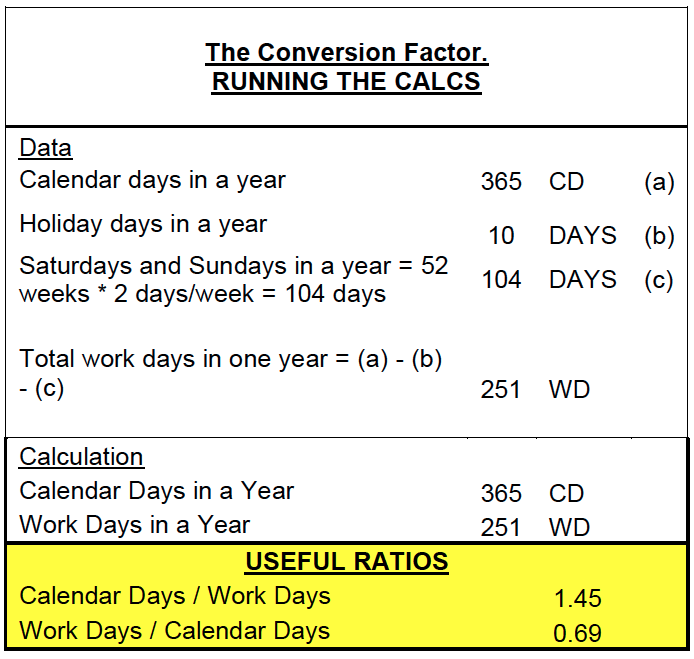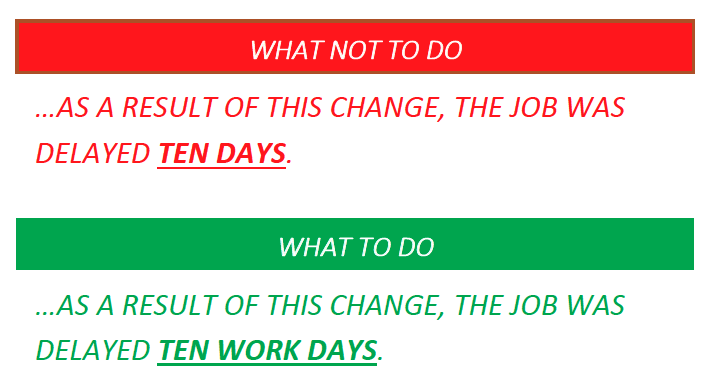Executive Summary
Construction contracts are almost always measured in some sort of day: a working day or a calendar day. In analysis and project communication, kill the doubt for the reader and always define the type of day in every use of the word “day”.
What’s a Work Day?
A work day or a working day or a business day, as they are found in contracts, carries some version of the following definition: a day on the calendar excluding holidays, Saturdays, and Sundays.
So, a typical week contains five working days (Monday, Tuesday, Wednesday, Thursday, and Friday) and two non-working days (Saturday and Sunday). If Monday is Memorial Day, then the calculation changes to 4 calendar days and 3 working days in that particular week.
What’s a Calendar Day?
A calendar day usually carries some sort of definition along the lines of a period of time from midnight to midnight. Mathematically it follows that there are 365 calendar days in a year (add one calendar day for a leap year making 366 calendar days per leap year).
The Conversion Factor
It’s helpful to have a general sense of the ratio between work days and calendar days for on-the-fly calculations or in client discussions. The calculation is provided below:

Insult my Client?
Now, to the point of this article. You just read the hard part of this article. Now the easy part. Always label your days with “calendar days” or “work days”, or whatever the appropriate unit of measure designation is. Always label your days with “calendar days” or “work days”, yes I said it twice. Almost insulting wasn’t it? But clear. Why do we care so much that this “day” is defined? Because not clearly defining the type of day can cost you time and money:

If you do not include the definition of the days you can cost yourself time and money. Say, for example, each work day you are on the job your overhead cost is $1,000/work day. Look at a possible interpretation of the money owed you in the red versus green scenario:
Red Scenario:
Owner owes 10 calendar days * 0.69 WD/CD
= 6.9 WD * $1,000/WD = $7,000
Green Scenario:
Owner owes 10 work days * $1,000/WD
= $10,000
Why was there confusion? Because you didn’t clearly communicate the units of measure in the red scenario. You didn’t insult the owner with simplicity and constant unit of measure definition.
My Story
I do a lot of schedule analysis and claims work wherein tables of data, narrative, and conversation about “days” are routinely discussed. Each time I hear the word “day” without the type of day it grinds on me. It irks me because time is money and both Contractor and Owner should have a clear definition of the cost and or time savings/delay which are being discussed.
Don’t be afraid to insult the client I say. Use your words:
Don’t say “Analysis of the schedule delay shows ten days of schedule loss due to one day of poor weather and six days of lost time due to our inability to access the work area. We hereby ask for $500 per day @ ten days = $5,000.”
Instead, try “Analysis of the schedule shows one work day (WD)lost due to poor weather and six work days lost due to XYZ Contractor, LLC not being able to access the work area. These seven work days are equal to ten calendar days based upon my calculation of calendar days to work days shown on the attachment. We hereby ask for a ten calendar day time extension to the contract which equates to increased overhead cost for XYZ Contractor, LLC in the amount of $500/CD * 10 CD = $5,000.”
May seem like a lot of over simplication and may seem wordy, but it’s clear! Crystal clear here: [QR]

Work safe!
Related Articles






0 Comments